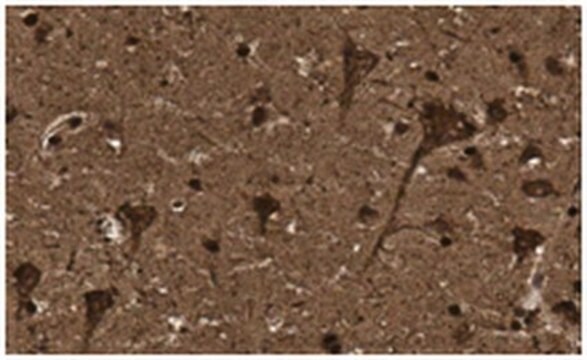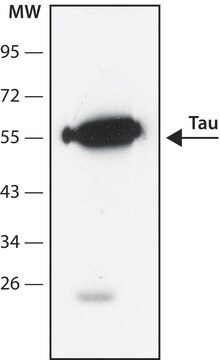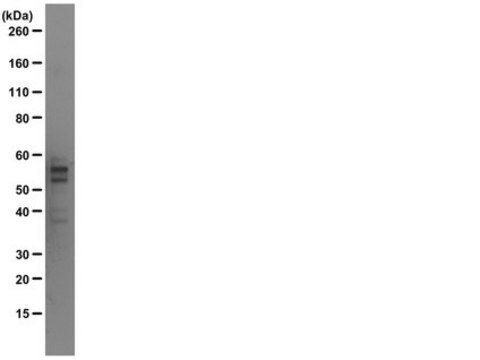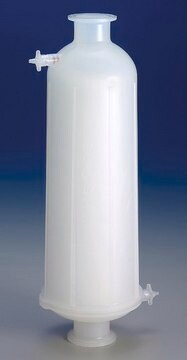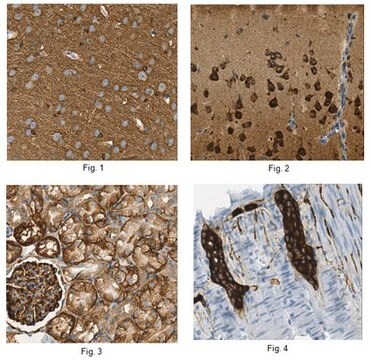ABN454-I
抗-Tau(T22)抗体(低聚体)
from rabbit, purified by affinity chromatography
同義詞:
Microtubule-associated protein tau oligomer, Tau oligomer, PHF-tau oligomer, Paired helical filament-tau oligomer, Neurofibrillary tangle protein oligomer
登入查看組織和合約定價
全部照片(4)
About This Item
分類程式碼代碼:
12352203
eCl@ss:
32160702
NACRES:
NA.41
無性繁殖:
polyclonal
application:
DB
IF
IHC
WB
IF
IHC
WB
物種活性:
human
技術:
dot blot: suitable
immunofluorescence: suitable
immunohistochemistry: suitable
western blot: suitable
immunofluorescence: suitable
immunohistochemistry: suitable
western blot: suitable
citations:
1
推薦產品
生物源
rabbit
品質等級
抗體表格
affinity isolated antibody
抗體產品種類
primary antibodies
無性繁殖
polyclonal
純化經由
affinity chromatography
物種活性
human
技術
dot blot: suitable
immunofluorescence: suitable
immunohistochemistry: suitable
western blot: suitable
NCBI登錄號
UniProt登錄號
運輸包裝
ambient
目標翻譯後修改
unmodified
基因資訊
human ... MAPT(4137)
一般說明
微管相关蛋白tau(UniProt P10636;也称为神经原纤维缠结蛋白,双股螺旋细丝tau,PHF-tau)由人的MAPT(也称为TAU,MAPT1,MTBTL)基因(基因ID 4137)编码。在阿尔茨海默′病(AD)病理中,微管相关蛋白tau的积累主要发生在神经元中。Tau在神经元的细胞体树突状和轴突域中积累。Tau还以神经原纤维缠结(NFT)的形式积累在体细胞中。细胞死亡和突触病变的发生与NFT的形成无关,研究表明仅NFT的形成不足以实现神经变性,这表明可溶性tau聚集体可能是更具毒性和病理学意义的tau物种。当将Tau寡聚体细胞外应用于培养的神经元细胞时,具有神经毒性,并且Tau寡聚体(但不是原纤维)在体内诱导神经变性以及突触和线粒体功能障碍。此外,研究人员能够使用tau寡聚体作为可靠的生物标志物来区分AD大脑和年龄匹配的非AD大脑。
特異性
T22特异性识别并中和寡聚tau,T22对单体tau、tau原纤维、Aβ寡聚体、Aβ原纤维、α-突触核蛋白寡聚体或α-突触核蛋白原纤维没有任何显著的反应性(Lasagna-Reeves, C. A., et al. (2012).FASEB J. 26(5):1946-1959).
免疫原
重组人Tau-441(Tau-F,Tau-4,2N4R亚型)寡聚体(Lasagna-Reeves, C. A., et al. (2012).FASEB J. 26(5):1946-1959).
應用
研究类别
神经科学
神经科学
蛋白印迹分析:4-6.67 µg/mL的代表性批次在阿尔茨海默′病(AD)患者的额叶皮层组织裂解液中检测到tau寡聚体,但是在年龄匹配的非AD人脑中没有检测到(由加尔维斯敦得克萨斯大学Rakez Kayed教授提供)。
斑点印迹分析:一个代表性批次在PS19转基因小鼠的海马齿状回(DG)和内侧内嗅皮层(MEC)组织裂解液中检测到人P301S tau寡聚体。Daily N-SMase 抑制剂GW4869腹腔注射液减少DG中tau寡聚体的聚集,但是对MEC无效(Asai, H., et al. (2015).Nat. Neurosci. 18(11):1584-1593)。
斑点印迹分析:一个代表性批次在阿尔茨海默′病(AD)患者以及年老的非AD 患者内侧颞回(medial temporal gyrus)组织裂解液中检测到tau寡聚体形成增加(Blair, L.J., et al. (2013).J Clin Invest. 123(10):4158-4169)。
免疫组化分析:一个代表性批次在石蜡包埋的亨廷顿病大脑纹状体切片中检测到人tau寡聚体(Vuono, R., et al. (2015).Brain.138(Pt 7):1907-1918)。
免疫组织化学分析:采用4%多聚甲醛固定的自由浮动脑切片, 在表达FKBP51的AAV病毒颗粒注射后, 一个代表性批次在Tg4510小鼠CA3区中检测到人tau P301L突变体寡聚体形成增加(Blair, L.J., et al. (2013).J Clin Invest. 123(10):4158-4169)。
免疫荧光:通过在内侧内嗅皮层(MEC)接受重组病毒注射液的小鼠脑切片的荧光免疫组化染色,一个代表性批次检测到含有病毒表达的人P301L突变体 tau 1 441 的颗粒细胞层(GCL)神经元(Asai, H., et al. (2015).Nat. Neurosci. 18(11):1584-1593)。
免疫荧光分析:通过石蜡包埋组织切的荧光免疫组织化学染色,在表达人tau并带有G272V和 P301S突变的THY-Tau22转基因小鼠的脑CA1区,一个代表性批次检测到与人AD脑中氧化核酸损伤标志物8-OH(d)G tau 寡聚体共定位的tau 寡聚体增多,以及热应激(HS)诱导的 Tau寡聚体形成((Violet, M., et al. (2015).Neurobiol.Dis.82:540-551)。
蛋白质印迹分析:一个代表性批次在PS19转基因小鼠中检测到含人P301S tau寡聚体的外泌体部分(exosomal fraction)。膳食补充 CSF-1R 抑制剂PLX3397可减少外泌体tau 寡聚体聚集(Asai, H., et al. (2015).Nat. Neurosci. 18(11):1584-1593)。
未纯化的抗血清(货号ABN454)也适用于斑点印迹、ELISA、免疫荧光、免疫组化、免疫沉淀、中和和蛋白质印迹应用。
斑点印迹分析:一个代表性批次在PS19转基因小鼠的海马齿状回(DG)和内侧内嗅皮层(MEC)组织裂解液中检测到人P301S tau寡聚体。Daily N-SMase 抑制剂GW4869腹腔注射液减少DG中tau寡聚体的聚集,但是对MEC无效(Asai, H., et al. (2015).Nat. Neurosci. 18(11):1584-1593)。
斑点印迹分析:一个代表性批次在阿尔茨海默′病(AD)患者以及年老的非AD 患者内侧颞回(medial temporal gyrus)组织裂解液中检测到tau寡聚体形成增加(Blair, L.J., et al. (2013).J Clin Invest. 123(10):4158-4169)。
免疫组化分析:一个代表性批次在石蜡包埋的亨廷顿病大脑纹状体切片中检测到人tau寡聚体(Vuono, R., et al. (2015).Brain.138(Pt 7):1907-1918)。
免疫组织化学分析:采用4%多聚甲醛固定的自由浮动脑切片, 在表达FKBP51的AAV病毒颗粒注射后, 一个代表性批次在Tg4510小鼠CA3区中检测到人tau P301L突变体寡聚体形成增加(Blair, L.J., et al. (2013).J Clin Invest. 123(10):4158-4169)。
免疫荧光:通过在内侧内嗅皮层(MEC)接受重组病毒注射液的小鼠脑切片的荧光免疫组化染色,一个代表性批次检测到含有病毒表达的人P301L突变体 tau 1 441 的颗粒细胞层(GCL)神经元(Asai, H., et al. (2015).Nat. Neurosci. 18(11):1584-1593)。
免疫荧光分析:通过石蜡包埋组织切的荧光免疫组织化学染色,在表达人tau并带有G272V和 P301S突变的THY-Tau22转基因小鼠的脑CA1区,一个代表性批次检测到与人AD脑中氧化核酸损伤标志物8-OH(d)G tau 寡聚体共定位的tau 寡聚体增多,以及热应激(HS)诱导的 Tau寡聚体形成((Violet, M., et al. (2015).Neurobiol.Dis.82:540-551)。
蛋白质印迹分析:一个代表性批次在PS19转基因小鼠中检测到含人P301S tau寡聚体的外泌体部分(exosomal fraction)。膳食补充 CSF-1R 抑制剂PLX3397可减少外泌体tau 寡聚体聚集(Asai, H., et al. (2015).Nat. Neurosci. 18(11):1584-1593)。
未纯化的抗血清(货号ABN454)也适用于斑点印迹、ELISA、免疫荧光、免疫组化、免疫沉淀、中和和蛋白质印迹应用。
该兔多克隆抗-Tau(T22)(寡聚体,货号ABN454-I)抗体可检测 Tau寡聚体的水平,已有相关文献发表并经验证可用于斑点印迹、免疫荧光、免疫组化和蛋白质印迹。
品質
通过重组人tau的斑点印迹分析进行评估。
斑点印迹分析:2 µg/mL的该抗体检测到100 ng体外生成的重组人tau寡聚体,但是没有检测到tau单体。
斑点印迹分析:2 µg/mL的该抗体检测到100 ng体外生成的重组人tau寡聚体,但是没有检测到tau单体。
標靶描述
根据寡聚体的大小而变化。在一些裂解液中可能会观察到未表征的条带。
外觀
不含防腐剂的PBS中纯化的兔多克隆抗体。
亲和纯化。
儲存和穩定性
自收到之日起在-20°C可稳定保存1年。
使用建议:收货后,在取下瓶盖之前,将小瓶离心并轻轻混合溶液。分装到微量离心管中,并储存于-20°C。避免反复冻融循环,以免损坏IgG和影响产品性能。
使用建议:收货后,在取下瓶盖之前,将小瓶离心并轻轻混合溶液。分装到微量离心管中,并储存于-20°C。避免反复冻融循环,以免损坏IgG和影响产品性能。
其他說明
浓度:请参考特定批次的数据表。
免責聲明
除非我们的产品目录或产品附带的其他公司文档另有说明,否则我们的产品仅供研究使用,不得用于任何其他目的,包括但不限于未经授权的商业用途、体外诊断用途、离体或体内治疗用途或任何类型的消费或应用于人类或动物。
未找到適合的產品?
試用我們的產品選擇工具.
儲存類別代碼
12 - Non Combustible Liquids
水污染物質分類(WGK)
WGK 2
閃點(°F)
Not applicable
閃點(°C)
Not applicable
分析證明 (COA)
輸入產品批次/批號來搜索 分析證明 (COA)。在產品’s標籤上找到批次和批號,寫有 ‘Lot’或‘Batch’.。
我們的科學家團隊在所有研究領域都有豐富的經驗,包括生命科學、材料科學、化學合成、色譜、分析等.
聯絡技術服務
